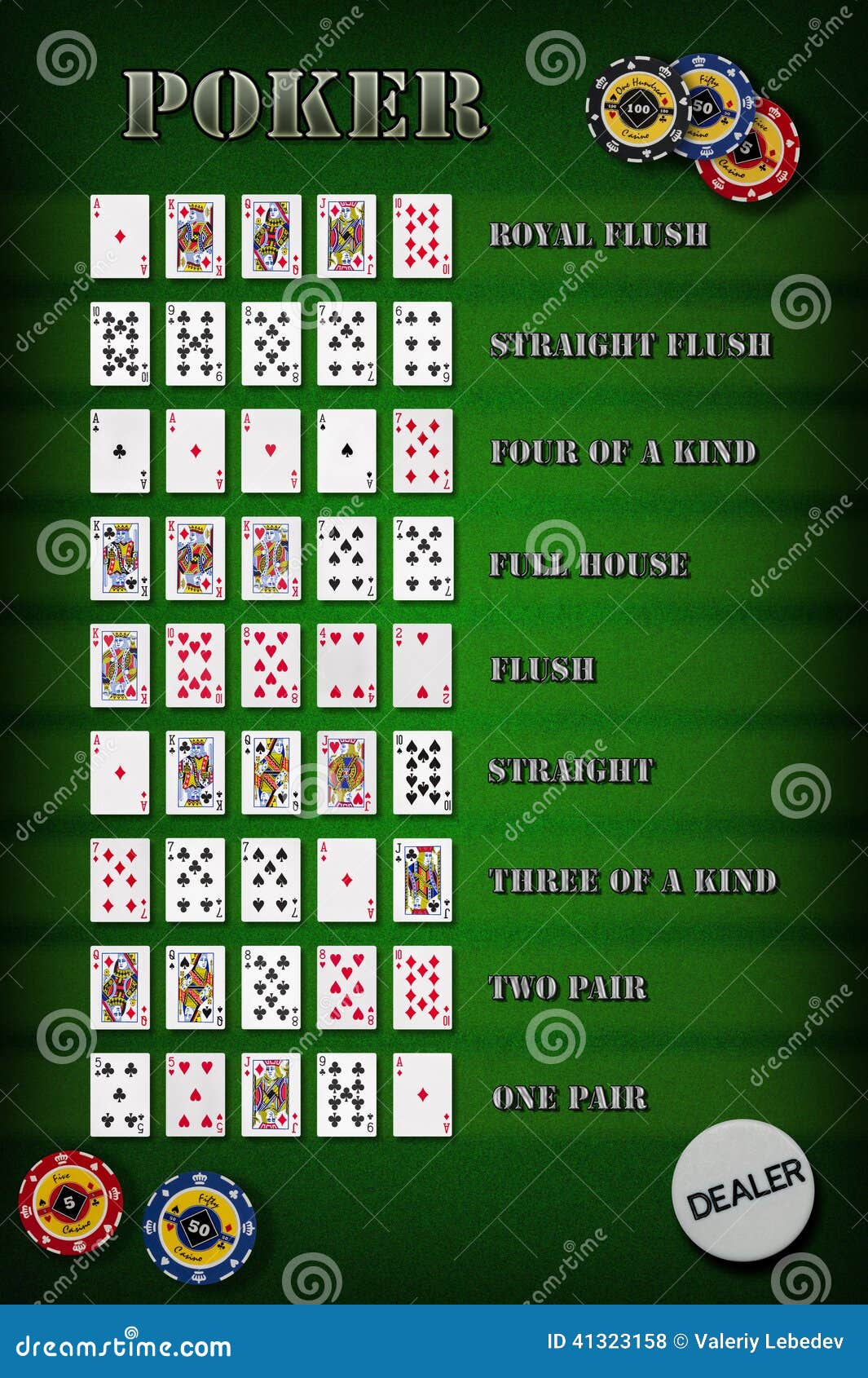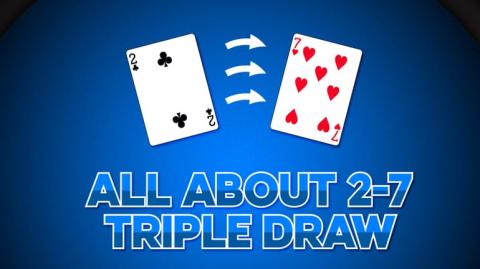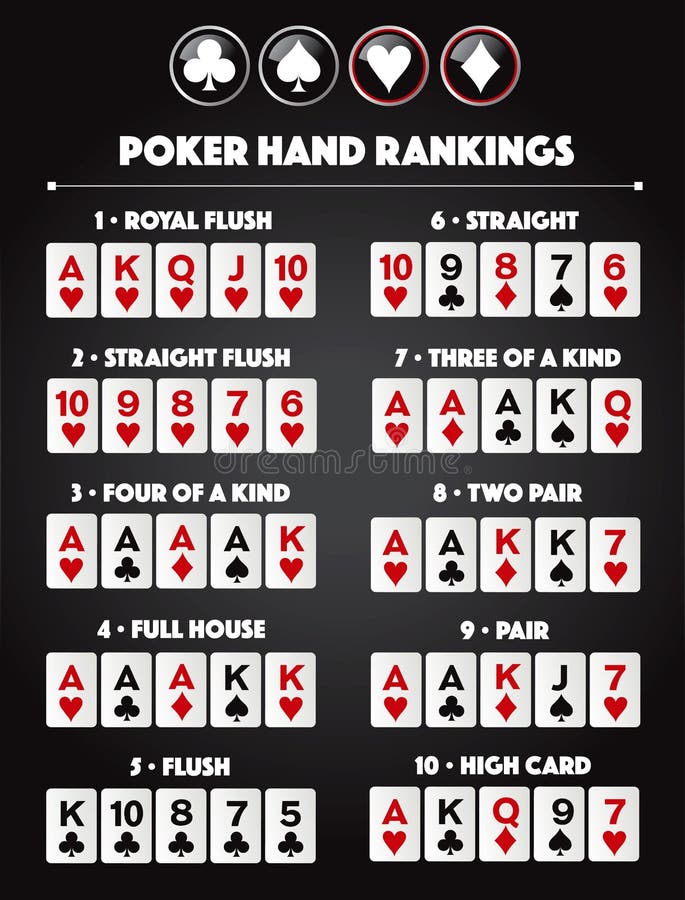2 7 Poker Hand Rankings

Poker Hand Rankings. How to Play Poker. Buttons & Blinds. Poker hands from highest to lowest 1. Royal flush A, K, Q, J, 10, all the. 2-7 Low hand ranking is used in 2-7 Triple Draw, as well as Badeucy. 2-7 ranking is the exact inverse of traditional high hand ranking. Official poker rankings: ties and kickers. Poker is all about making the best five-card poker hand from the seven cards available (five community cards plus your own two hole cards). That means in the event of a tie with four of a kind, three of a kind, two pair, one pair, or high card, a side card, or 'kicker', comes into play to decide who. In the event of a tie: All Five-high hands split the pot. Six Low: Any five unpaired cards with the highest card being a Six. In the event of a tie: The lower second-highest ranking card wins the pot. Thus 6,4,3,2,A defeats 6,5,4,2,A. If necessary, the third-highest, fourth-highest and fifth-highest cards in the hand can be used to break the tie. While this hand can further be divided into Trips and Sets, this does not change the hand's value, which ranks 7 th in the poker hands rankings list of Texas Holdem. Here are a couple of examples of possible 3 of a Kind poker hands: K K K J 3; Q Q Q 7 2; 8 8 8 A 5; 2 2 2 9 6.
Types of Hand Rankings
- Badugi >
High Hands
Traditional High Hand ranking is used in most games to determine the best 5-card hand. Hand strength, from weakest to strongest:
- High Card – Five unrelated cards with no pairs, ranked from highest card down.
- One Pair – A pair and three unrelated cards, ranked by the size of the pair. When pairs tie, the ranks of the unrelated cards (called kickers) are compared.
- Two Pair – Two pairs and an unrelated card, ranked first by the size of the larger pair, then by the size of the smaller pair. When both pairs tie, the kicker is compared.
- Three of a Kind – Three of a kind and two unrelated cards, ranked as pairs are ranked.
- Straight – Five sequentially connected cards, ranked by the highest card. An Ace may play low for an A-2-3-4-5 straight.
- Flush – Five cards of the same suit, ranked from the highest card down.
- Full House – Three of a kind and a pair, ranked first by the size of the three of a kind, then by the size of the pair.
- Four of a Kind – All four of a kind and one unrelated card, ranked as pairs are ranked.
- Straight Flush – Five sequentially connected cards of the same suit, ranked by the highest card.
- Royal Flush – The highest possible straight flush from Ten to Ace.
Short Deck High Hands
Short Deck hand ranking is used when playing Short Deck Hold'em. Because the deck contains no 2's, 3's, 4's or 5's, ranking varies from normal high hands in the following ways:
- An Ace may play low for an A-6-7-8-9 straight.
- Three of a kind beats a straight.
- A flush beats a full house.
The Short Deck order of hand strength, from weakest to strongest, is: High Card, One Pair, Two Pair, Straight, Three of a Kind, Full House, Flush, Four of a Kind, Straight Flush, Royal Flush.
A-5 Lowball Hands

A-5 Low hand ranking is used to award the low half of the pot in all hi/lo games, including Omaha Hi/Lo and Stud Hi/Lo. A-5 hand ranking is also used in the games Razz and Badacey.

- Aces play low.
- Straights and flushes do not count against the hand.
- The best possible low hand is 5-4-3-2-A.
Low hands are ranked from their highest card down:
- A player with the hand 7-6-5-3-2 (a 7-Low) would win against a player holding 8-5-3-2-A (an 8-Low).
- If both players have the same high card, the next highest card is compared. The hand 8-6-5-4-2 (an 8-6 Low) wins against 8-7-5-4-A (an 8-7 Low).
- Players with identically ranked 5-card low hands tie and split the pot.
If neither player has a high-card hand (for example, if both players have a pair or stronger), hands are compared using traditional high hand rankings, and the lowest hand wins.
In Hi/Lo split games with an 8-or-better qualifier, players must make an 8-Low or better to compete for the low half of the pot.
2-7 Lowball Hands
2-7 Low hand ranking is used in 2-7 Triple Draw, as well as Badeucy. 2-7 ranking is the exact inverse of traditional high hand ranking.
- Aces play high.
- Straights and flushes count against the hand.
- The best possible low hand is 7-5-4-3-2.
Low hands are ranked from their highest card down:
- A player with the hand 8-7-6-5-3 (an 8-Low) would win against a player holding 9-5-4-3-2 (a 9-Low).
- If both players have the same high card, the next highest card is compared. The hand 8-6-5-4-3 (an 8-6 Low) wins against 8-7-4-3-2 (an 8-7 Low).
- Players with identically ranked 5-card low hands tie and split the pot.
If neither player has a high-card hand (for example, if both players have a pair or stronger), hands are compared using traditional high hand rankings, and the lowest hand wins.

Badugi
Badugi hand ranking is used in the games Badugi, Badacey and Badeucy. Badugi hands are ranked differently from traditional lowball rankings.

- Unlike 5-card poker hands, badugi hands consist of 4 cards at most.
- Aces play low, except in Badeucy.
- Straights and flushes do not apply to badugi hands.
- Only cards of distinct rank and suit may be played towards a badugi hand.
- Two cards of the same rank or same suit count against the hand, and may not both be played.
- The best possible hand is 4-3-2-A of four different suits.
Hands are ranked first by how many distinct cards can be played:
- A 4-card hand (also called a badugi) contains four cards of distinct rank and suit, and beats any hand that can only play three cards.
- A 3-card hand contains only three cards of distinct rank and suit, but wins against any hand that cannot play at least three cards. The same rule extends to 2-card and 1-card hands.
2 7 Poker Hand Rankings Chart
Hands playing the same amount of cards are ranked from their highest card down:
A player with 9-7-4-A of four different suits (a 9-Badugi) would win against a player holding J-3-2-A of four different suits (a Jack-Badugi).
2 7 Poker Hand Rankings Printable
If both players have the same high card, the next highest card is compared. The hand 9-6-5 of three different suits (a 3-card 9-6) wins against 9-7-A of three different suits (a 3-card 9-7).
Players with identically sized and ranked hands tie and split the pot.